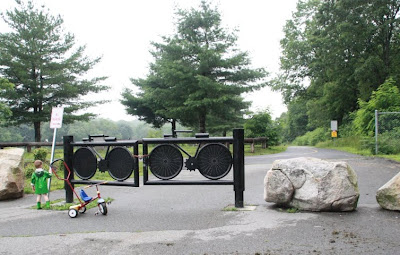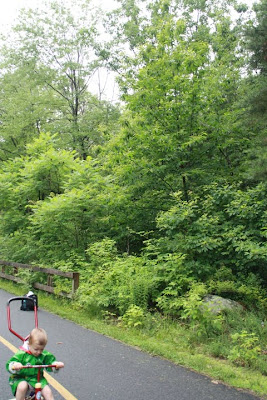
While I was out with a friend walking the Milford Section of the Upper Charles Trail, we stopped so that I could nurse Kaylee. While shooing away mosquitoes, I noticed that there was a lot of American chestnut regrowth in the area. And then I saw that the largest of them was covered in catkins.
Kathy Desjardin at the American Chestnut Society has confirmed from a photo I sent that this is an American Chestnut, and that it has female flowers, which means that if they can get permission in time, and if it has enough female flowers to be worth their while, they can pollinate this tree as a part of their breeding program.

The bike path starts from a parking lot off of Dilla Street, at Louisa Lake.

This is the gate leading to the path. (And a note for the folks at TACF, the path is large enough for a truck. Turning the truck around in there would be difficult, however, and the gate is locked.)

The tree is here, by a "pull off area", less than a mile down the path. The backpack on the path marks the location of the tree.

Here it is, by the end of the fence, with my son as scale reference.
The tree is ten or fifteen feet from the path, down an incline, and surrounded by raspberry brambles and other plants. (But there was no poison ivy that I could see, at least.)

I was wearing Kaylee at the time, so I couldn't safely get in there to make a measurement or assess the health of the trunk. But I could see this much from the path.

Here is a view showing a slightly lower segment of the trunk. I don't know if that vertical mark is a feature of chestnut bark, or evidence of blight.
Fiddling around with a piece of string and a ruler, I guestimate the diameter of the tree at 4.5 feet from where I think the ground is to be about 16 inches.

Kathy was curious if we could figure out from my photos how many nuts the tree is making. I couldn't see female flowers on all of the clusters of catkins. . .

. . .but this one has four.

Here is a close-up of the female flowers. Each one will become a nut.

This one has four as well.

Here is another shot of the tree.

This is the same photo, cropped in close. I have placed a purple dot at the location of every catkin cluster I could see in the photo. There are about fifty dots. So, my conservative estimate would be fifty nuts. More wishfully, two hundred. I don't know how many potential nuts would make this tree worth the TACF's time, since pollinating a tree requires a large truck and someone with a lot of patience.

This is the remains of another American chestnut tree nearby. This one also made it to a good 20 feet tall before it was killed by the blight. The live one is 25 or 30 feet. Hopefully it lasts a few productive seasons before dying.

I never thought I would see an American chestnut blooming in the wild, much less find one myself. I don't have adequate words to describe how I feel right now. I had to tell my friends that this is like seeing a unicorn.
Tomorrow I plan on going to the Cranberry Bog at Patriot Place, because there is another American chestnut there, too, that I spotted last month. It is of a similar size, and appears to be suffering from blight. I'll get some photos for TACF. Hopefully it is blooming, too.







4 comments:
This is really cool!
I found it interesting. I have three of those trees in my property in Milford. We have been collecting and eating the chestnuts for many years now.
If you take Paypal, I'll tip you for this.
Haha, thanks Maia. You could make a donation to the American Chestnut Foundation: http://www.acf.org/ :)
loli, that's fantastic! It is possible that your trees are another variety of chestnut. The TACF can help you identify them for sure. http://www.acf.org/find_a_tree.php If you post photos online, I may be able to help, too.
Cheers!
(michelle, posting from Chris's account)
Post a Comment